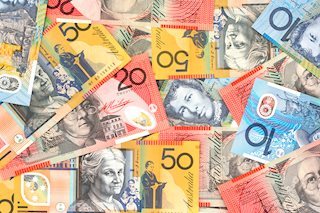Australian Dollar down as US Dollar emerges
|
- AUD/USD value has dropped due to consistent gains in the US Dollar.
- Monetary policy divergence between the RBA and the Fed could provide some relief to AUD/USD.
- Uncertainty surrounding China's economic outlook and stimulus efforts remains a key challenge for the Aussie.
The AUD/USD pair has declined in the Monday session, following consistent gains in the US Dollar. The pair fell by 0.80% to 0.6655 at the time of writing. The declines in the Aussie have been attributed to concerns over China's stimulus measures and recent weakness in copper prices.
However, monetary policy divergence between the Reserve Bank of Australia (RBA) and the Federal Reserve (Fed) could provide some support to AUD/USD, but the uncertainty surrounding China's economic outlook remains a key challenge for the currency. Investors remain vigilant to incoming Aussie data, as it might delay the start of the RBA’s easing cycle.
Daily digest market movers: Australian Dollar declines based on China, copper news
- Persistent weakness in copper prices and a modest decline in iron ore prices further weighed on the Australian Dollar.
- The RBA is keeping its cash rate steady at 4.35% and demands further data to start cutting rates.
- That being said, the latest meeting minutes revealed a more dovish outlook, increasing market expectations of a 25-basis-point rate cut by year-end.
- Elsewhere, deputy Governor Hauser warned that Australian rates would not drop as much or as soon as other central banks due to persistent inflation.
- This might benefit the Aussie as its peers have already started cutting rates. Higher rates might attract foreign investors, bolstering demand for the Australian currency.
AUD/USD technical outlook: Pair faces ongoing selling pressure
The technical outlook for the AUD/USD suggests ongoing selling pressure, indicated by the Relative Strength Index (RSI) close to the oversold area with a declining slope. This signals increasing momentum behind the sell-off. Furthermore, the Moving Average Convergence Divergence (MACD) histogram is red and rising, reinforcing the bearish bias.Significant support levels include 0.6650, 0.6630 and 0.6600, while resistance can be found at 0.6700, 0.6715 and 0.6750.
RBA FAQs
The Reserve Bank of Australia (RBA) sets interest rates and manages monetary policy for Australia. Decisions are made by a board of governors at 11 meetings a year and ad hoc emergency meetings as required. The RBA’s primary mandate is to maintain price stability, which means an inflation rate of 2-3%, but also “..to contribute to the stability of the currency, full employment, and the economic prosperity and welfare of the Australian people.” Its main tool for achieving this is by raising or lowering interest rates. Relatively high interest rates will strengthen the Australian Dollar (AUD) and vice versa. Other RBA tools include quantitative easing and tightening.
While inflation had always traditionally been thought of as a negative factor for currencies since it lowers the value of money in general, the opposite has actually been the case in modern times with the relaxation of cross-border capital controls. Moderately higher inflation now tends to lead central banks to put up their interest rates, which in turn has the effect of attracting more capital inflows from global investors seeking a lucrative place to keep their money. This increases demand for the local currency, which in the case of Australia is the Aussie Dollar.
Macroeconomic data gauges the health of an economy and can have an impact on the value of its currency. Investors prefer to invest their capital in economies that are safe and growing rather than precarious and shrinking. Greater capital inflows increase the aggregate demand and value of the domestic currency. Classic indicators, such as GDP, Manufacturing and Services PMIs, employment, and consumer sentiment surveys can influence AUD. A strong economy may encourage the Reserve Bank of Australia to put up interest rates, also supporting AUD.
Quantitative Easing (QE) is a tool used in extreme situations when lowering interest rates is not enough to restore the flow of credit in the economy. QE is the process by which the Reserve Bank of Australia (RBA) prints Australian Dollars (AUD) for the purpose of buying assets – usually government or corporate bonds – from financial institutions, thereby providing them with much-needed liquidity. QE usually results in a weaker AUD.
Quantitative tightening (QT) is the reverse of QE. It is undertaken after QE when an economic recovery is underway and inflation starts rising. Whilst in QE the Reserve Bank of Australia (RBA) purchases government and corporate bonds from financial institutions to provide them with liquidity, in QT the RBA stops buying more assets, and stops reinvesting the principal maturing on the bonds it already holds. It would be positive (or bullish) for the Australian Dollar.
Information on these pages contains forward-looking statements that involve risks and uncertainties. Markets and instruments profiled on this page are for informational purposes only and should not in any way come across as a recommendation to buy or sell in these assets. You should do your own thorough research before making any investment decisions. FXStreet does not in any way guarantee that this information is free from mistakes, errors, or material misstatements. It also does not guarantee that this information is of a timely nature. Investing in Open Markets involves a great deal of risk, including the loss of all or a portion of your investment, as well as emotional distress. All risks, losses and costs associated with investing, including total loss of principal, are your responsibility. The views and opinions expressed in this article are those of the authors and do not necessarily reflect the official policy or position of FXStreet nor its advertisers.